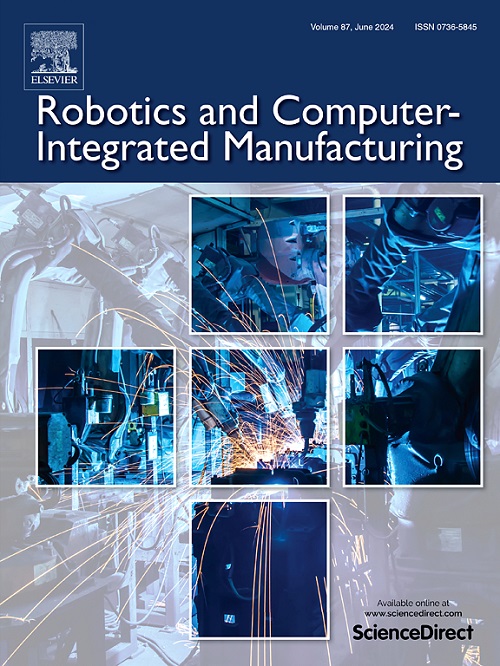基于多自由度成形件偏差的并联机构运动误差逆标定
IF 11.4
1区 计算机科学
Q1 COMPUTER SCIENCE, INTERDISCIPLINARY APPLICATIONS
引用次数: 0
摘要
在多自由度成形过程中,利用并联运动机构对成形机的运动误差进行标定是关键。然而,一方面,由于工作空间有限和成形过程高度动态,运动误差检测过程复杂。另一方面,由于成型机的运动学误差来源多样,运动学误差建模复杂。为此,本文提出了一种基于多自由度成形薄壁高肋构件(THC)的运动学误差逆标定方法,该方法简便、高效。首先,基于螺旋理论建立了PKM的最小误差模型,以最小的108个运动误差表示多误差源,建立了108个运动误差与上模运动误差的映射关系;然后,利用上模运动误差建立了多自由度成形THC的误差预测模型。研究发现,108个运动误差对上模运动误差和多自由度形成的THC偏差分布有不同的敏感性。在此基础上,规划了多自由度成形THC的最优标定点。建立了THC标定点偏差与上模运动误差的逆映射关系,实现了PKM运动误差的逆标定。最后,进行了多自由度成形实验,未经反校正的成形THC误差为-90 ~ 384 μm。经反定标后,最优定标点形成的THC偏差为-17 ~ 84 μm,随机定标点形成的THC偏差为-29 ~ 131 μm。也就是说,与不进行反校准相比,采用反校准的形成的THC的精度提高了约3 ~ 4倍。此外,与随机标定点相比,优化标定点可显著提高成型THC的精度约37%。研究表明,提出的基于多自由度成形THC偏差的PKM运动学误差逆标定方法是合理的。本文章由计算机程序翻译,如有差异,请以英文原文为准。
Inverse calibration of kinematic error for parallel kinematic mechanism based on deviation of multi-DOF formed component
In the multi-DOF forming process, it is critical to calibrate kinematic error for forming machine with parallel kinematic mechanism (PKM). However, on one hand, the detection process of kinematic error is complex due to the limited workspace and highly dynamic forming process. On the other hand, the kinematic error sources of forming machine are diverse and thus the kinematic error modeling is complex. So, this paper proposes a novel inverse calibration method of kinematic error for PKM based on deviation of multi-DOF formed thin-wall and high-rib component (THC), which is convenient and efficient. Firstly, the minimal error model of PKM is established based on screw theory, in which the minimal 108 kinematic errors are used to represent multi-error sources and the mapping relationship between 108 kinematic errors and upper die motion error is established. Then, the deviation prediction model of multi-DOF formed THC is established by the upper die motion error. It is found that 108 kinematic errors have different sensitivities to the upper die motion error and the distribution of multi-DOF formed THC deviation. Based on the above mechanism, the optimal calibration points on multi-DOF formed THC are planned. The inverse mapping relationship between the deviation of calibration points on THC and the upper die motion error is established, and the inverse calibration of kinematic error for PKM is realized. Finally, multi-DOF forming experiments of THC are carried out, and the deviation of formed THC without inverse calibration is -90∼384 μm. After the inverse calibration, the deviation of formed THC with optimal calibration points is -17∼84 μm while the deviation of formed THC with random calibration points is -29∼131 μm. That is, the accuracy of formed THC with inverse calibration is improved by about 3∼4 times compared to that without inverse calibration. Further, the accuracy of formed THC with optimal calibration points is significantly improved by about 37% compared to that with random calibration points. This research demonstrates that the proposed convenient and efficient inverse calibration method of kinematic error for PKM based on deviation of multi-DOF formed THC is reasonable.
求助全文
通过发布文献求助,成功后即可免费获取论文全文。
去求助
来源期刊
CiteScore
24.10
自引率
13.50%
发文量
160
审稿时长
50 days
期刊介绍:
The journal, Robotics and Computer-Integrated Manufacturing, focuses on sharing research applications that contribute to the development of new or enhanced robotics, manufacturing technologies, and innovative manufacturing strategies that are relevant to industry. Papers that combine theory and experimental validation are preferred, while review papers on current robotics and manufacturing issues are also considered. However, papers on traditional machining processes, modeling and simulation, supply chain management, and resource optimization are generally not within the scope of the journal, as there are more appropriate journals for these topics. Similarly, papers that are overly theoretical or mathematical will be directed to other suitable journals. The journal welcomes original papers in areas such as industrial robotics, human-robot collaboration in manufacturing, cloud-based manufacturing, cyber-physical production systems, big data analytics in manufacturing, smart mechatronics, machine learning, adaptive and sustainable manufacturing, and other fields involving unique manufacturing technologies.

 求助内容:
求助内容: 应助结果提醒方式:
应助结果提醒方式:


